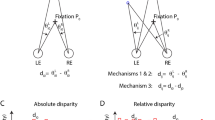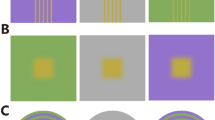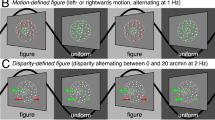Abstract
Vernier acuity shows that the human visual system can interpolate the relative position of a feature with astonishing precision, of the order of a fraction of the distance between neighbouring photoreceptors in the fovea. The remarkable properties of this interpolation process have been the subject of many recent studies1–9. A major question that is still unanswered is whether the process is parallel—operating automatically at all times over a large part of the visual field—or serial—operating selectively at isolated locations only when judgments in the hyperacuity range are required (as in a forced choice task). Successful fusion of random-line stereograms having breaks in the vernier acuity range has been previously interpreted10 to suggest that the interpolation process underlying hyperacuity is parallel and preliminary to stereomatching. Here we demonstrate with computer experiments that vernier cues are not needed to solve the stereomatching problem posed by these stereograms, and we provide psychophysical evidence that human stereopsis probably does not use vernier cues alone to achieve fusion of these random-line stereograms.
This is a preview of subscription content, access via your institution
Access options
Subscribe to this journal
Receive 51 print issues and online access
$199.00 per year
only $3.90 per issue
Buy this article
- Purchase on Springer Link
- Instant access to full article PDF
Prices may be subject to local taxes which are calculated during checkout
Similar content being viewed by others
References
Barlow, H. B. Nature 279, 189–190 (1979).
Barlow, H. B. Proc. R. Soc. B212, 1–34 (1981).
Westheimer, G. Am. J. Optom. physiol. Opt. 53 (7) 362–364 (1976).
Westheimer, G. & Hauske, G. Vision Res. 15, 1137–1141 (1975).
Westheimer, G. & McKee, S. P. Vision Res. 17 a, 89–93 (1977).
Westheimer, G. & McKee, S. P. Vision Res. 17 b, 941–947 (1977).
Westheimer, G. & McKee, S. P. Invest. Ophthalmol. Vis. Sci. 118, 614–621 (1979).
Crick, F. H. C., Marr, D. & Poggio, T. in The Cortex (ed. Schmitt, F. O.) (MIT Press, 1981).
Fahle, M. & Poggio, T. Proc. R. Soc. B213, 451–477 (1981).
Julesz, B. & Spivack, G. J. Science 157, 563–565 (1967).
Marr, D. & Poggio, T. Proc. R. Soc. B204, 301–328 (1979).
Marr, D. C. & Poggio, T. A.I. Memo 558 (Massachusetts Institute of Technology, 1980).
Grimson, W. E. L. From Images to Surfaces (MIT Press, 1981).
Marr, D. Vision (Freeman, San Francisco, 1982).
Mayhew, J. E. W. & Frisby, J. P. Artif. Intell. 17, 349–385 (1981).
Marr, D. & Poggio, T. Science 194, 283–287 (1976).
Marr, D., Poggio, T. & Palm, G. Biol. Cybern. 28, 223–239 (1978).
Julesz, B. Foundations of Cyclopean Perception (University of Chicago Press, 1971).
Nishihara, H. K. & Larson, N. G. Proc. DARPA Image Understanding Workshop 114–120 (Science Application Inc., Arlington, 1981).
Wilson, H. R. & Bergen, J. R. Vision Res. 19, 19–32 (1979).
Marr, D. & Hildreth, E. Proc. R. Soc. B207, 187–217 (1980).
Author information
Authors and Affiliations
Rights and permissions
About this article
Cite this article
Nishihara, H., Poggio, T. Hidden cues in random-line stereograms. Nature 300, 347–349 (1982). https://doi.org/10.1038/300347a0
Received:
Accepted:
Issue Date:
DOI: https://doi.org/10.1038/300347a0
This article is cited by
-
Vision: New depths in stereopsis
Nature (1983)
Comments
By submitting a comment you agree to abide by our Terms and Community Guidelines. If you find something abusive or that does not comply with our terms or guidelines please flag it as inappropriate.



